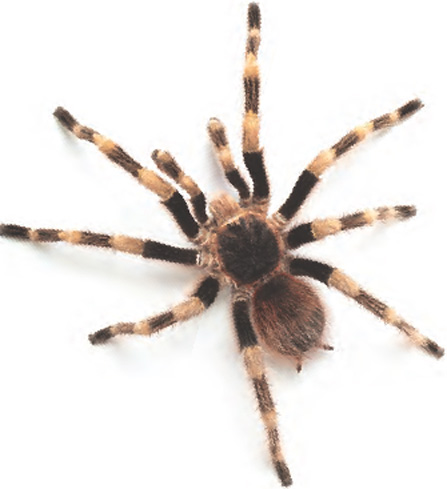13.3 Anxiety Disorders
Extreme Anxiety
LO 4 Define and illustrate an understanding of anxiety disorders and their causes.
Think about the objects or situations that cause you to feel afraid or uneasy. Maybe you fear creepy crawly insects, slithery snakes, or crowded public spaces. A mild fear of spiders or a very crowded subway is normal, but if you become highly disturbed by the mere thought of them, or if your fear interferes with your everyday functioning, then a problem may exist. People who suffer from anxiety disorders have extreme anxiety and/or irrational fears that are debilitating (TABLE 13.3).
| Anxiety Disorder | Annual Prevalence | Description | Cultural Impact |
|---|---|---|---|
| Separation anxiety disorder | 0.9–1.9% in adults; 1.6% in adolescents; 4% in children | Anxiety or fear related to “separation from home or attachment figures”. | Cultures vary with respect to age at which it is appropriate to move from parental home. |
| Specific phobia | 7–9% | Anxiety about, or fear of, a specific object or situation. | Specific phobias vary across cultures. |
| Social anxiety disorder (social phobia) | 7% | Anxiety about, or fear of being in, a social situation that could result in scrutiny by other people. | Taijin kyofu (Japan and Korea). |
| Panic disorder | 2–3% | Reoccurring panic attacks that are unexpected and for which there is no apparent cue or trigger. | Trúng gió (Vietnam); ataque de nervios (Latin America); khyâl (Cambodia). |
| Agoraphobia | 1.7% | Anxiety or fear regarding “using public transportation; being in open spaces; being in enclosed places; standing in line or being in a crowd; or being outside of the home”. | None listed in DSM–5. |
| Generalized anxiety disorder | 0.9% in adolescents; 2.9% in adults |
Anxiety and worry that are out of proportion to the actual event or situation. | Varies by culture. |
| Anxiety disorders are relatively common in both sexes, but they are more apparent in women by an approximate 2:1 ratio. | |||
| SOURCE: DSM–5 (AMERICAN PSYCHIATRIC ASSOCIATION, 2013). | |||
How do we differentiate between normal anxiety and an anxiety disorder? We look at the degree of dysfunction the anxiety causes, how much distress it creates, and whether it gets in the way of everyday behavior (interfering with relationships, social interactions, work, and time management, for example). Let’s take a look at some of the anxiety disorders identified in the DSM–5: panic disorder, specific phobia, agoraphobia, social anxiety disorder, and generalized anxiety disorder.
Panic Disorder
If you see somebody trembling and sweating, gasping for breath, or complaining of heart palpitations, what comes to mind? If you are concerned it’s a heart attack, you may be correct; call 911 immediately if you are not sure. What you may not know is that a person experiencing a panic attack may behave very similarly to someone having a heart attack. A panic attack is a sudden, extreme fear or discomfort that escalates quickly, often with no evident cause, and includes symptoms such as increased heart rate, sweating, shortness of breath, chest pain, nausea, lightheadedness, and fear of dying. A diagnosis of panic disorder requires such attacks to recur unexpectedly and have no obvious trigger. In addition, the person worries about having more panic attacks, or she feels as if she might be losing control. People with panic disorder often make decisions that are maladaptive, like purposefully avoiding exercise or places that are unfamiliar.
554

The Biology of Panic Disorder
Panic disorder does appear to have a biological cause (APA, 2013). Researchers have identified specific parts of the brain thought to be responsible for panic attacks, including regions of the hypothalamus, which is involved in the fight-or-flight response (Johnson et al., 2010). There is also evidence suggesting that people diagnosed with panic disorder have smaller amygdala. The amygdala is involved in fear and aggression, as well as the memories associated with those emotions. A smaller amygdala could lead to dysfunction in the autonomic nervous system (which directs the fight-or-flight response), resulting in behavioral and physical symptoms of panic attacks (Hayano et al., 2009).
CONNECTIONS
In Chapter 2, we described how the sympathetic division of the autonomic nervous system directs the body’s stress response. When a stressful situation arises, the sympathetic nervous system prepares the body to react, causing the heart to beat faster, respiration to increase, and the pupils to dilate, among other things.
Genetics, Gender, and Panic Disorder
Panic disorder affects about 2–3% of the population (APA, 2013). Research indicates that panic disorder runs in families, with heritability estimates around 40–48% (Maron, Hettema, & Shlik, 2010; Weber et al., 2012). This means that over 40% of the variation of the disorder in the population can be attributed to genetic factors and the remaining 60% is due to environmental factors. In other words, the frequency and distribution of panic disorder across people result from a combination of factors, 40% of which are due to genes and 60% to nongenetic factors. People often assume heritability refers to an individual’s risk for the disorder (“Her panic disorder is 40% the result of her genes, and 60% due to her environment”). This is incorrect. Remember, heritability explains the variation and risk among individuals in a population.
Women are twice as likely to be diagnosed with panic disorder, and this disparity is already apparent by the age of 14 (APA, 2013; Craske et al., 2010; Weber et al., 2012). Such gender differences may have a biological basis, but we must also consider the psychological and social factors that might contribute.
Learning and Panic Disorder
Some researchers propose that learning— particularly classical conditioning—can play a role in the development of panic disorder (Bouton, Mineka, & Barlow, 2001). In a panic disorder scenario, the neutral stimulus might be something like a location (a shopping mall), the unconditioned stimulus an unexpected panic attack, and the unconditioned response the fear resulting from the panic attack. The panic attack location (the shopping mall) would become the conditioned stimulus, such that every time the person thinks of the shopping mall, she responds with fear (now the conditioned response).
CONNECTIONS
In Chapter 5, we described how, for Little Albert, an originally neutral stimulus (a rat) was paired with an unconditioned stimulus (a loud sound), which led to an unconditioned response (fear). With repeated pairings, the conditioned stimulus (the rat) led to a conditioned response (fear).
555
Cognition and Panic Disorder
Other researchers suggest there is a cognitive component of panic disorder, with some individuals misinterpreting physical sensations as signs of major physical or psychological problems (Clark et al., 1997; Teachman, Marker, & Clerkin, 2010). For example, many people have a strange sensation when their hearts skip a beat (technically known as arrhythmia), but they realize it is probably not serious, perhaps just the result of too much coffee. A person with panic disorder might interpret that sensation as an indication of an imminent heart attack.
Specific Phobias and Agoraphobia
Panic attacks can occur without apparent triggers. This is not the case with a specific phobia, which centers on a particular object or situation, like rats or airplane travel. Most people who have a phobia do their best to avoid the feared object or situation. If avoidance is not possible, they withstand it, but only with extreme fear and anxiousness. Take a look at TABLE 13.4 for a list of some specific phobias.
| Scientific Name | Fear of … |
|---|---|
| Acrophobia | Heights |
| Astraphobia or keraunophobia | Lightning |
| Brontophobia | Thunder |
| Claustrophobia | Closed spaces |
| Cynophobia | Dogs |
| Epistemophobia | Knowledge |
| Gamophobia | Marriage |
| Ophidiophobia | Snakes |
| Odontophobia | Dental procedures |
| Xenophobia | Strangers |
| A person with a specific phobia feels extreme anxiety about a particular object or situation. Fears center on anything from dogs to dental procedures. | |
| SOURCE: REBER, ALLEN, AND REBER (2009). | |

Learning and Specific Phobias
As with panic disorder, phobias can be explained using the principles of learning (LeBeau et al., 2010). Classical conditioning may lead to the acquisition of a fear, through the pairing of stimuli. Operant conditioning could maintain the phobia, through negative reinforcement; if anxiety (the unpleasant stimulus) is reduced by avoiding a feared object or situation, the avoidance behavior is negatively reinforced and thus more likely to recur. Observational learning can also help explain the development of a phobia. Simply watching someone else experience a phobia could create fear in an observer. Some research demonstrates that even rhesus monkeys become afraid of snakes if they observe other monkeys reacting fearfully to real or toy snakes (Heyes, 2012; Mineka, Davidson, Cook, & Keir, 1984).
CONNECTIONS
In Chapter 5, we discussed negative reinforcement; behaviors increase when they are followed by the removal of something unpleasant. Here, the avoidance behavior takes away the anxious feeling, increasing the likelihood of avoiding the object in the future.

Biology, Culture, and Specific Phobias
Phobias can also be understood through the lens of evolutionary psychology. Humans seem to be biologically predisposed to fear certain threats such as spiders, snakes, foul smells, and bitter foods. In particular, people appear to be afraid of and disgusted by spiders, perhaps because they can be dangerous, but there appears to be a cultural component of this reaction as well (Gerdes, Uhl, & Alpers, 2009). From an evolutionary standpoint, these fears would tend to protect us from true danger. But sometimes the link between anxiety and evolution is less apparent. It’s hard to imagine how an intense fear of being in public, for example, would promote survival.
556
Agoraphobia
Do you ever feel a little anxious when you are out in public, in a new city, or at a crowded amusement park? A person with agoraphobia (a-gə-rə-′fō-bē-ə) feels extremely anxious in these types of settings. This disorder is characterized by a distinct fear or anxiety related to public transportation, open spaces, retail stores, crowds, or being alone and away from home in general. Someone with agoraphobia consistently avoids these situations and fears she will be unable to escape. Agoraphobia may also result in “panic-like symptoms,” which can be difficult to handle. Typically, people with agoraphobia need another person to accompany them on outings, because they feel they may not be able to cope on their own. They may avoid situations they fear, or be overwhelmed with fear when avoidance is not possible. As with other anxiety disorders, the fear felt by someone with agoraphobia is beyond what might be expected in a particular cultural context (APA, 2013).
Social Anxiety Disorder

According to the DSM–5, a person with social anxiety disorder (social phobia) has a distinct fear of social situations and scrutiny by others. What causes this severe anxiety? It could occur during a speech or presentation, while eating a meal, or simply in an intimate conversation. Social anxiety often stems from a preoccupation with offending someone or behaving in a way that reveals one’s anxiety. This extreme fear is not warranted, however. Being evaluated or even mocked by others is not necessarily a dangerous situation and should not cause debilitating stress. This type of social anxiety, where one fears the judgment and scrutiny of others, is what psychologists often observe in Western societies. In other parts of the world, social anxiety may take a different form.
across the WORLD
The Many Faces of Social Anxiety
 Every society has its own collection of social norms, so it’s not surprising that social anxiety presents itself in distinct ways across the world. People in Asian cultures, for example, are more likely to avoid outward displays of anxiety, such as blushing, sweating, or shaking. Some individuals in Japan and Korea suffer from taijin kyofu, a cultural syndrome characterized by an intense fear of offending or embarrassing other people with one’s body odor, stomach rumblings, or facial expressions. Note that with taijin kyofu, the fear is associated with causing distress in others, as opposed to oneself, which is typical of social anxiety disorder in Western cultures (Hofmann, Asnaani, & Hinton, 2010; Kinoshita et al., 2008). This distinction may relate to the fact that Japanese and Korean cultures are more collectivist than Western cultures (Rapee & Spence, 2004). Collectivist cultures value social harmony over individual needs, so causing discomfort in others is worse than personal humiliation.
Every society has its own collection of social norms, so it’s not surprising that social anxiety presents itself in distinct ways across the world. People in Asian cultures, for example, are more likely to avoid outward displays of anxiety, such as blushing, sweating, or shaking. Some individuals in Japan and Korea suffer from taijin kyofu, a cultural syndrome characterized by an intense fear of offending or embarrassing other people with one’s body odor, stomach rumblings, or facial expressions. Note that with taijin kyofu, the fear is associated with causing distress in others, as opposed to oneself, which is typical of social anxiety disorder in Western cultures (Hofmann, Asnaani, & Hinton, 2010; Kinoshita et al., 2008). This distinction may relate to the fact that Japanese and Korean cultures are more collectivist than Western cultures (Rapee & Spence, 2004). Collectivist cultures value social harmony over individual needs, so causing discomfort in others is worse than personal humiliation.
BODY ODOR AND OTHER CULTURAL AFFRONTS
557
The anxiety disorders we have discussed thus far relate to specific objects and scenarios. You can predict that a person with agoraphobia will feel distressed walking through an enormous shopping mall, and there is a good chance that someone with social phobia will feel very uncomfortable at a cocktail party. But what about anxiety that is more pervasive, affecting many aspects of life?
Generalized Anxiety Disorder
Someone with generalized anxiety disorder experiences an excessive amount of worry and anxiety about many activities relating to family, health, school, and other aspects of daily life (APA, 2013). The psychological distress is accompanied by physical symptoms such as muscle tension and restlessness. Individuals with generalized anxiety disorder may avoid activities they believe will not go smoothly, spend a great deal of time getting ready for such events, or wait until the very last minute to engage in the anxiety-producing activity. Like other disorders, the anxiety must cause substantial distress in social settings or work environments to merit a diagnosis.
Twin studies suggest there is a hereditary component to generalized anxiety disorder. This genetic factor appears to be associated with irregularities in parts of the brain associated with fear, such as the amygdala and hippocampus (Hettema et al., 2012; Hettema, Neale, & Kendler, 2001). Environmental factors such as adversity in childhood and overprotective parents also appear to be associated with the development of generalized anxiety disorder (APA, 2013).
We introduced this section with the story of Melissa Hopely, a young woman who performed elaborate rituals to combat her anxiety. Her behavior caused significant distress and dysfunction, which suggests that it was abnormal, but does it match with any of the anxiety disorders described above? Her anxiety was not attached to a specific object or situation, so it doesn’t appear to fit the description of a phobia. Nor was her anxiety widespread and nonspecific, as might be the case with generalized anxiety disorder. Melissa’s fears emanated from nagging, dreadful thoughts generated by her own mind. She may not have been struggling with an anxiety disorder per se, but she certainly was experiencing anxiety as a result of some disorder. So what was it?
show what you know
Question 13.8
1. Someone with a diagnosis of panic disorder will experience unexpected and recurrent:
- comorbidity.
- medical illnesses.
- panic attacks.
- dramatic mood swings.
Question 13.9
2. A behaviorist might propose that you acquire a phobia through ______________, but the maintenance of that phobia could be the result of ____________.
Question 13.10
3. People suffering from taijin kyofu tend to worry more about embarrassing others than they do about being embarrassed themselves. Yet in Western cultures, the opposite is true. What characteristics of the two cultures might lead to these differences in the expression of anxiety?
 CHECK YOUR ANSWERS IN APPENDIX C.
CHECK YOUR ANSWERS IN APPENDIX C.
558